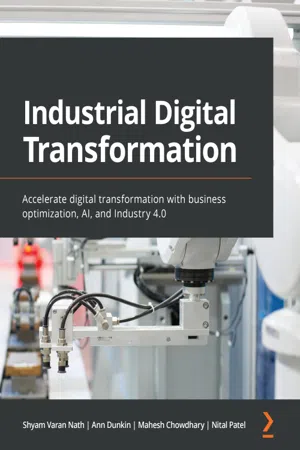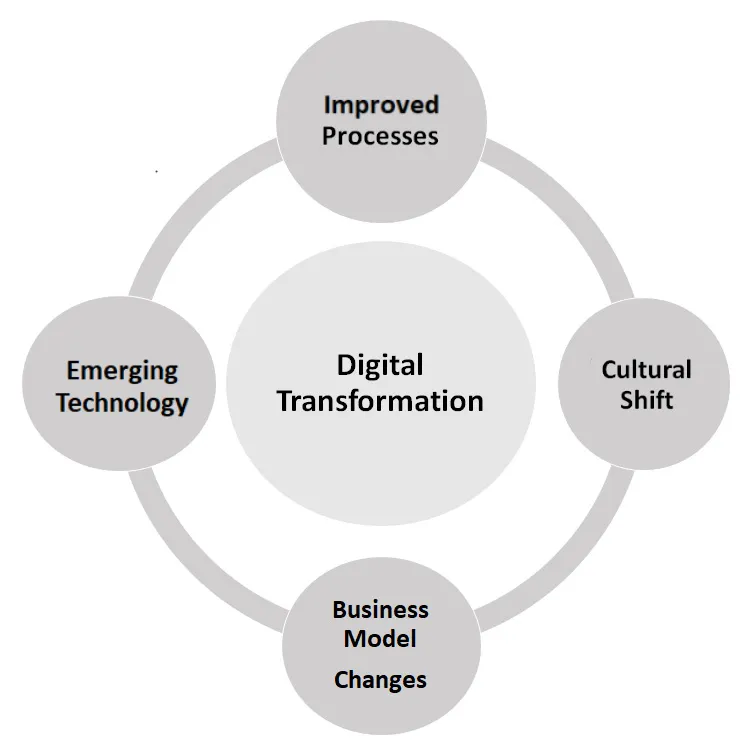Section 1: The "Why" of Digital Transformation
You will learn why digital transformation is an important trend in the industry and why every company needs to understand it.
This part of the book comprises the following chapters:
- Chapter 1, Introducing Digital Transformation
- Chapter 2, Transforming the Culture in an Organization
- Chapter 3, Accelerating Digital Transformation with Emerging Technologies
- Chapter 4, Industrial Digital Transformation
Chapter 1: Introducing Digital Transformation
Industrial digital transformation is the journey that organizations undertake where they integrate business model change, process improvement, and cultural shift, often leveraging a number of digital and emerging technologies. We will refer to industrial digital transformation often in the context of companies from the commercial or public sector that deal with physical assets, factories, and field operations, generally dealing with business-to-business scenarios, and the transformation involves improvements in these products, equipment, and operations. On the other hand, when the transformation involves software or business enhancements for asset-light or pure tertiary services companies, including business-to-consumer scenarios, then we will refer to it as digital transformation. To include both, we will refer to it simply as transformation. Likewise, our use of the term industrial includes both the commercial and public sectors, in the same way as industrial revolutions have used this term.
On the one hand, this book will be a guide for business leaders, Line of Business (LoB) managers, C-suite executives, including the Chief Information Officer (CIO) and Chief Technology Officer (CTO), and digital leaders to help identify opportunities for transformation. On the other hand, this book will provide mid-career professionals in Information Technology (IT) and business with recipes for success in the transformation journey, both in terms of digital technology selection and implementation, to help achieve the associated business outcomes. This book will prepare technology professionals to influence business decision makers toward industrial digital transformation. In this process, mid-career professionals will achieve significant professional advancement.
In this chapter, we'll be exploring the following topics:
- Exploring industrial digital transformation
- Identifying the business drivers for industrial digital transformation
- The evolution of industrial transformation
- The impact of industrial digital transformation on business
- Quantifying business outcomes and shareholder value
- The phases of the digital transformation journey
Exploring industrial digital transformation
Industrial digital transformation may often bring a radical rethinking to the use of technology, culture, people, and processes in an enterprise. This can lead to a fundamental change in business performance and outcomes, as well as how the customers perceive the company. Figure 1.1 provides an easy way to look at the transformation. It shows that culture and technology changes go hand in hand with the business process and business model changes. Several books have been written on the broad topic of digital transformation, and some of these will be referenced here. George Westerman and Didier Bonnet wrote a book en titled Leading Digital: Turning Technology into Business Transformation, George Westerman, Didier Bonnet, Andrew McAfee, Harvard Business Review Press, published in 2014:
Figure 1.1 – Digital transformation
The technologies used to help drive an industrial digital transformation may include one or more from the Internet of Things (IoT), cloud and edge computing, Artificial Intelligence (AI), big data and analytics, blockchain, robotics, drones, 3D printing, Augmented Reality (AR) and Virtual Reality (VR), Robotic Process Automation (RPA), and mobile technologies. New technologies continue to emerge, so this list is not meant to be an exhaustive one. The main goal of these transformations is to gain a competitive advantage, drive new revenues, improve productivity and efficiency, as well as enhance customer and stakeholder engagement. The term technology, or digital technology, in the context of industrial digital transformation is not limited to software or IT only. It may include physical, chemical, or biological/life sciences-related technologies as well. For example, in the context of autonomous vehicles, it can be Light Detection and Ranging (LIDAR) or a more efficient car battery. In an industrial safety context, it can be a sensor or a system for fall detection or a thermal scanning camera for infectious disease detection or prevention. These emerging technologies that often accelerate industrial digital transformation will be covered in detail in Chapter 3, Emerging Technologies to Accelerate Digital Transformation.
According to the Customer Insights & Analysis group of the International Data Corporation (IDC), the worldwide investment in industrial digital transformation-related initiatives is expected to exceed $6 trillion over the next 4 years (2020–2024): see (https://www.businesswire.com/news/home/20190424005113/en/Businesses-Spend-1.2-Trillion-Digital-Transformation-Year). Smart manufacturing will account for a large part of this spending. Other sectors, such as finance, retail and logistics management, and transportation, will also undergo a large-scale industrial digital transformation.
In April 2020, while delivering the quarterly earnings of Microsoft, their CEO, Satya Nadella, said We've seen 2 years' worth of digital transformation in 2 months. Interestingly, this book has been written around the same time frame and has captured many recent transformative initiatives. In the next section, we will learn about the business drivers for industrial digital transformation.
Identifying the business drivers for industrial digital transformation
The power of transformation applies to some or every aspect of an organization. It can generate business value, agility, and resilience. The importance of resilience is shown at the time of local or global crises. This book will focus on driving transformation in industries – in both commercial and public sectors – to accelerate business outcomes, by deploying the digital technologies in combination with transformative planning and shifts in the culture.
The different forces that help to shape the industrial digital transformation in an organization are shown in Figure 1.2. The industrial digital transformation often entails a series of big bets or bold steps, to achieve large-scale benefits or competitive advantage. This differentiates transformation from regular generational changes, which are often linear or a series of small and gradual steps. Humans climbed mountains through the historic ages and eventually climbed Mount Everest. However, the same series of incremental improvements could not land a human on the moon. This is probably an extreme example of scaling new heights in the history of humanity. But so is a level 5 autonomous car (see https://www.nhtsa.gov/technology-innovation/automated-vehicles-safety#topic-road-self-driving) compared to the first car with an internal combustion engine built in 1885 [Germany Patent DRP No. 37435]:
Figure 1.2 – Industrial digital transformation forces
Figure 1.2 shows the change agents on the left-hand side, such as the business process and model changes, with support from technological and cultural shifts. This is often forced by traditional competitors or disrupters. The regulatory changes and the expectations of the customers as well as the shareholders change over time. Transformation helps to ensure that productivity, profitability, and social responsibility improve and align with the stakeholders.
Business drivers in the commercial sector
In the commercial sector, often, the need for industrial digital transformation is driven by two kinds of strategy:
- Defensive strategy
- Offensive strategy
The defensive strategy of transformation refers to protecting the business from competitors and disrupters. Most car manufacturers started manufacturing electric vehicles as a defensive strategy. According to Moody's, traditional US car manufacturers lose $7,000 to $10,000 per electric vehicle. The major reason why car manufacturers continue to invest in electric vehicles is that this market is expected to grow by almost 20% in the next decade. With breakthrough innovations expected in battery and related technologies, the cost of production is expected to go down.
While most automobile manufacturers pursued a defensive strategy, Tesla is an example of using an offensive strategy, where it is trying to disrupt the rest of the industry. A large part of both outlook and forecasts in the automobile industry today has been driven by Tesla, which was founded in 2003 and is newer than most US and global auto giants. Today, it reduces some of its losses by charging a price premium by differentiating itself based on becoming a status symbol and offering driver-assisted technologies. Tesla is not a profitable company as of early 2020, but is aggressively reducing losses because of lifestyle status and innovation that enables them to charge a price premium. Tesla is a good example of industrial digital transformation at work in the automotive industry. The Tesla Semi is targeted to disrupt the trucking industry next.
Tesla's approach is to futureproof their cars with the necessary hardware that will make the cars increasingly autonomous in the near future with Over-the-Air (OTA) updates. This will increase Tesla's market valuation as well as the value of Tesla cars for the current owners. While Tesla, being a newer company, is free of cumbersome legacy processes, there a...


